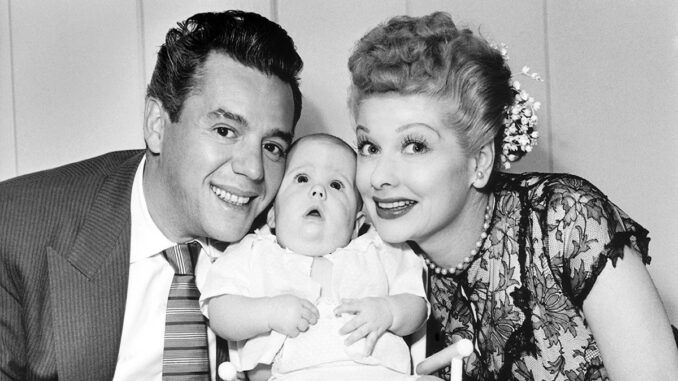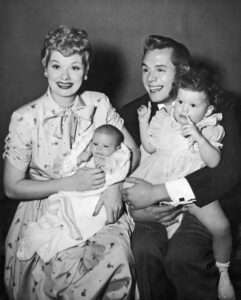
Introduction: A Day That Blended Life and Art
Imagine living one of the most iconic days of your life while simultaneously shaping television history. For Lucille Ball, January 19, 1953, wasn’t just another workday; it was a day where her personal life and professional career collided in a way that no one had ever seen before. On this historic day, Ball gave birth to her real-life son, Desi Arnaz Jr., while America’s favorite TV couple, Lucy and Ricky Ricardo, welcomed their on-screen baby into the world.
Let’s dive into how this extraordinary coincidence came to be and why it still resonates with audiences decades later.
The Genius of Lucille Ball and Desi Arnaz
How ‘I Love Lucy’ Revolutionized TV
Before “I Love Lucy,” television was still finding its footing. Lucille Ball and her husband, Desi Arnaz, created a sitcom that wasn’t just funny—it was groundbreaking. From its use of a live audience to filming with multiple cameras, the show redefined how television was made.
But their most daring move? Incorporating Ball’s real-life pregnancy into the storyline at a time when pregnancy was a taboo topic on TV.

Breaking Barriers with Humor
In 1952, the idea of showing a pregnant woman on TV was unheard of. Network executives were hesitant, worried about offending conservative audiences. But Ball and Arnaz pushed back, insisting that Lucy Ricardo’s pregnancy was a natural progression of the story.
The Parallel Storylines: Life Imitating Art
Lucy’s On-Screen Pregnancy
The “Lucy Is Enceinte” episode aired in December 1952, using the French word for pregnant to skirt controversy. Audiences were delighted, and the storyline became one of the most popular arcs in the show’s history.
The Real-Life Pregnancy Behind the Scenes
Behind the cameras, Ball’s real pregnancy mirrored her on-screen character’s journey. The timing was impeccable: Ball’s due date aligned perfectly with the filming schedule for the birth episode.
The Big Day: January 19, 1953
A Historic Broadcast
On January 19, 1953, the episode “Lucy Goes to the Hospital” aired to an audience of over 44 million viewers. That same day, Ball gave birth to Desi Arnaz Jr. in Los Angeles.
Breaking Records
The episode shattered viewership records, drawing more attention than Dwight Eisenhower’s presidential inauguration the next day. It was a cultural phenomenon that cemented “I Love Lucy” as a timeless classic.
Why This Moment Matters
Changing TV Forever
Lucille Ball’s dual motherhood moment wasn’t just a personal milestone; it was a societal shift. By normalizing pregnancy on television, Ball helped pave the way for more authentic storytelling in entertainment.
A New Standard for Sitcoms
The success of the baby storyline set a precedent for blending real-life experiences with fictional narratives. Audiences loved the authenticity, and other shows quickly followed suit.
Behind-the-Scenes Drama
Network Hesitation
CBS initially refused to allow the word “pregnant” to be spoken on air, deeming it too risqué. The creative team worked around this with clever dialogue and situational comedy.
The Pressure on Ball
Filming while pregnant wasn’t easy. Ball’s commitment to her craft, despite the physical demands, showcased her dedication and resilience.
Legacy of the Dual Motherhood Moment
Desi Arnaz Jr.: A Celebrity Baby
Desi Arnaz Jr. became a celebrity the moment he was born. His life was forever intertwined with the legacy of “I Love Lucy.”
Lucy Ricardo’s Baby
Little Ricky, Lucy’s on-screen son, also became a beloved character, symbolizing the joys and challenges of parenthood.
Fun Facts About This Iconic Event
- The Episode Title Debate: The writers debated for weeks on the perfect title for the birth episode.
- Audience Reactions: Letters poured in from fans sharing their own pregnancy stories.
- Airing Across Time Zones: Special arrangements were made to ensure the episode aired simultaneously nationwide.
- Ball’s Superstition: Lucille Ball reportedly avoided discussing the plot of the birth episode, fearing it might jinx her real delivery.
- Cultural Impact: The episode was later referenced in numerous TV shows as a benchmark for great sitcom writing.
How Lucille Ball’s Legacy Lives On
Lucille Ball’s groundbreaking moment continues to inspire actors, writers, and producers. Her ability to blend her real and fictional lives showed the world that authenticity resonates with audiences.
Conclusion: A Moment for the Ages
Lucille Ball’s historic day as both a real mom and a TV mom remains one of the most remarkable moments in television history. It wasn’t just about the birth of a baby—it was about the birth of a new era in entertainment. By daring to be real, Ball and Arnaz proved that life’s best stories are often the ones we live ourselves.
FAQs
1. What made Lucille Ball’s dual motherhood moment so special?
It combined real-life and fictional storytelling in a way that had never been done before, creating a moment that resonated deeply with audiences.
2. Why was showing pregnancy on TV controversial in the 1950s?
At the time, pregnancy was considered a private matter, and many networks feared it might offend viewers.
3. How did the audience react to the birth episode?
The episode drew over 44 million viewers, making it one of the most-watched TV events of its time.
4. Did Lucille Ball face challenges while filming pregnant?
Yes, but her professionalism and dedication allowed her to deliver a stellar performance despite the physical demands.
5. How does this moment influence modern TV?
It set a precedent for integrating real-life events into fictional narratives, paving the way for more relatable and authentic storytelling.
